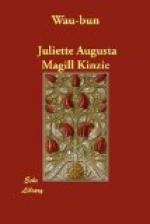On the northern bank of the river, directly facing the fort, was the family mansion of my husband.[22] It was a long, low building, with a piazza extending along its front, a range of four or five rooms. A broad green space was inclosed between it and the river, and shaded by a row of Lombardy poplars. Two immense cottonwood-trees stood in the rear of the building, one of which still remains as an ancient landmark. A fine, well-cultivated garden extended to the north of the dwelling, and surrounding it were various buildings appertaining to the establishment—dairy, bake-house, lodging-house for the Frenchmen, and stables.
A vast range of sand-hills, covered with stunted cedars, pines, and dwarf-willow-trees, intervened between the house and the lake, which was, at this time, not more than thirty rods distant.
Proceeding from this point along the northern bank of the river, we came first to the Agency House, “Cobweb Castle,” as it had been denominated while long the residence of a bachelor, and the sobriquet adhered to it ever after. It stood at what is now the southwest corner of Wolcott[23] and N. Water Streets. Many will still remember it, a substantial, compact little building of logs hewed and squared, with a centre, two wings, and, strictly speaking, two tails, since, when there was found no more room for additions at the sides, they were placed in the rear, whereon a vacant spot could be found.
These appendages did not mar the symmetry of the whole, as viewed from the front, but when, in the process of the town’s improvement, a street was maliciously opened directly in the rear of the building, the whole establishment, with its comical little adjuncts, was a constant source of amusement to the passers-by. No matter. There were pleasant, happy hours passed under its odd-shaped roof, as many of Chicago’s early settlers can testify.
Around the Agency House were grouped a collection of log buildings, the residences of the different persons in the employ of Government, appertaining to that establishment—blacksmith, striker, and laborers. These were for the most part Canadians or half-breeds, with occasionally a stray Yankee, to set all things going by his activity and enterprise.
There was still another house on the north side of the river, built by a former resident by the name of Miller, but he had removed to “Riviere du Chemin,” or Trail Creek, which about this time began to be called “Michigan City."[24] This house, which stood near the forks of the river, was at this time vacant.
There was no house on the southern bank of the river, between the fort and “The Point,” as the forks of the river were then called. The land was a low wet prairie, scarcely affording good walking in the dryest summer weather, while at other seasons it was absolutely impassable. A muddy streamlet, or, as it is called in this country, a slew,[25] after winding around from about the present site of the Tremont House, fell into the river at the foot of State Street.[26]




